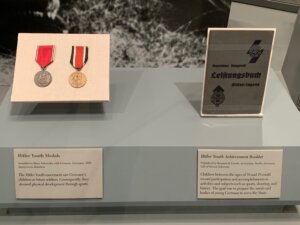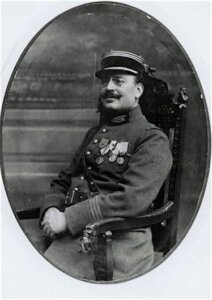FIRST PERSONWhat would you do if you got a Nazi relic in the mail?

Left, Hitler Youth medal won by Nazi soldier Hans Sukowski. Right, Hans’ mother, Elly, holding a neighbor’s baby, standing next to her husband, Israel Schaechter, with a yellow star on his jacket, in Nazi-occupied France. Courtesy of Museum of Jewish Heritage (medal) and Peter Janovsky (portrait)
When a package from France arrived at my Manhattan apartment, I imagined it had something to do with Israel Schaechter, my great-uncle. I’d been researching his life story. He was a highly decorated Jewish World War I veteran and doctor who survived World War II hidden by farmers in occupied France. People who knew him were sending me memorabilia in response to my inquiries.
But the package was not what I expected. Inside was a red box with a swastika on it containing two Hitler Youth medals.
How did they get to me?

On a trip to France in 1997 to trace my great-uncle’s footsteps, I’d met a man named Bertrand Cerf who fondly remembered Dr. Schaechter from his youth in St. Avold, a town on the German border. When I asked Bertrand about the medals Israel had won in World War I, he reached out to an elderly nephew of Israel’s wife. The nephew sent me five of Israel’s medals, including the Légion d’Honneur, France’s highest honor, and a medal for the bloody Dardanelles campaign in Turkey.
I sent a note of thanks to the nephew, who was living in a nursing home, and asked whether he had any other memorabilia. That was when he sent the Hitler Youth medals.
The Hitler Youth medals belonged to Hans Sukowski, whose mother Elly had married my uncle after divorcing Hans’ father. Hans moved to Germany with his dad and died fighting for the Nazis in World War II. Elly’s nephew thought they might be of interest to me as part of my great-uncle’s story.
He was wrong.
‘Like a plague’
The Hitler Youth medals were like a plague to me. I stuffed them in a filing cabinet where I couldn’t see them, but their mere presence was disturbing. It was as though they were fouling the apartment. Within days, I donated them to the Museum of Jewish Heritage in New York.
Reading about right-wing megadonor Harlan Crow’s collection of Nazi memorabilia triggered memories of my reaction to receiving the medals 25 years ago. Crow is the billionaire who cultivated a friendship with Supreme Court Justice Clarence Thomas and treated him to lavish vacations and other gifts. Despite statutory guidelines, Thomas failed to disclose the gifts, even though they are said to be worth millions.
Crow’s collection includes a copy of Mein Kampf signed by Adolf Hitler and two of Hitler’s paintings. His supporters defend the collection — which also includes statues of Stalin, Lenin and other dictators — as a way of recognizing the horrors of the 20th century, claiming he hates communism and fascism. This explanation is highly questionable at best. His house is not a museum where Nazi items have context. He sought the items out and proudly displays them.
This story was in the news for a few days and then faded from coverage, another step in the normalization of aberrant behavior we have seen over the last eight years, including racism, sexual assault and authoritarian behavior like that of Texas Gov. Greg Abbott’s stunt dropping off busloads of migrants on the freezing streets of Washington D.C. last Christmas eve.
The museum display
Unlike Crow’s Nazi collection, the Museum of Jewish Heritage displayed the Hitler Youth medals in an appropriate historical context, as an example of the Third Reich’s indoctrination of young people. The accompanying text read: “The Hitler Youth Movement saw Germany’s children as future soldiers.” That was certainly the case with Elly’s son, who died on the Eastern Front.

When my twin daughters — one of whom is named Isabel, in part to honor Uncle Israel — took a field trip to the museum with their Hebrew school classmates, I went along and shared Israel’s story.
One of the medals remains on display today and can be seen in the museum’s main exhibition, The Holocaust: What Hate Can Do.
Surviving the war
Dr. Schaechter was born in Constantinople to a Jewish family of Eastern European origin. While his seven sisters ultimately emigrated to the United States, he moved to France where he attended medical school at the University of Nancy. France later granted him citizenship for service and heroism in World War I.
After the war, he settled in St. Avold. He hired Elly as a nurse and housekeeper after his first wife died, and they married in 1939.

Germany invaded France in 1940. Israel and Elly then fled to a town in the occupied western part of France. As a Jew, Israel could no longer practice medicine and had to wear the yellow star with the word Juif on his clothing. A photo of the couple shows him with the star on his jacket and Elly with a cross around her neck, holding a neighbor’s baby.
In 1944, a neighbor told Israel that German officials planned to deport him, giving him a chance to flee to the woods outside of town. When the Germans came to the door, Elly staved them off, saying Israel was out for the day. That night the couple escaped to a remote farmhouse owned by Francois and Leontine Naffrechoux — so remote, the French call it le bout du monde, the ends of the earth.
Traveling in Israel’s footsteps
Israel and Elly spent the rest of the war hidden with other fugitives in the farmhouse. I became intrigued with their ordeal after reading a short history written by their neighbor. I wrote to mayors of the various towns where my uncle had lived, and visited the towns in 1997 with my wife Fran.
At the farmhouse where Israel and Elly hid, we met the rescuers’ son Andre Naffrechoux. Andre was about 75 by then; he’d been 22 in 1944. He told us about his parents’ bravery as we sat around the same table where Israel had sat with them. “They arrived,” he said, “and there was never any doubt that we would take them in.”

After a harrowing year in hiding, Israel and Elly returned to St. Avold when France was liberated in late 1944. But many friends — and their savings — were gone. In a 1947 letter, Israel wrote that he was still working long hours as a doctor at age 71: “If not for the war, I could have hung up my apron.” He died two years later. Elly died in 1955, leaving the medals — both good and bad, to her nephew.
Tracing Uncle Israel’s story changed my life. I wrote a full account of my journey in a blogpost called Gifts from a Spiritual Ancestor. I also nominated Francois and Leontine Naffrechoux posthumously as Righteous Among the Nations, an honor that Yad Vashem, the Holocaust memorial in Jerusalem, bestows upon non-Jews who risked their lives to save Jews from the Nazis. The nomination was approved, and a friend later sent me a rubbing of the place on the wall at Yad Vashem where their names are inscribed.
Unlike the Hitler Youth medals, the rubbing is an artifact worth keeping.

I hope you appreciated this article. Before you go, I’d like to ask you to please support the Forward’s award-winning journalism this Passover.
In this age of misinformation, our work is needed like never before. We report on the news that matters most to American Jews, driven by truth, not ideology.
At a time when newsrooms are closing or cutting back, the Forward has removed its paywall. That means for the first time in our 126-year history, Forward journalism is free to everyone, everywhere. With an ongoing war, rising antisemitism, and a flood of disinformation that may affect the upcoming election, we believe that free and open access to Jewish journalism is imperative.
Readers like you make it all possible. Right now, we’re in the middle of our Passover Pledge Drive and we need 500 people to step up and make a gift to sustain our trustworthy, independent journalism.
Make a gift of any size and become a Forward member today. You’ll support our mission to tell the American Jewish story fully and fairly.
— Rachel Fishman Feddersen, Publisher and CEO
Join our mission to tell the Jewish story fully and fairly.
Our Goal: 500 gifts during our Passover Pledge Drive!
























